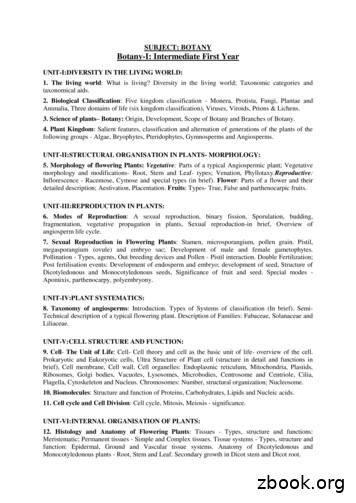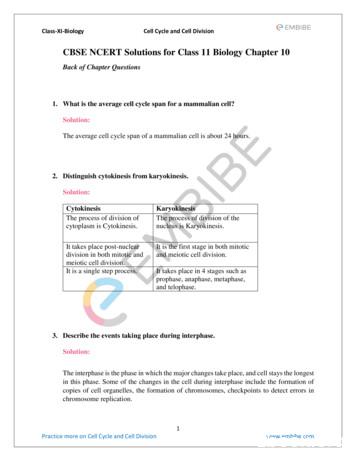Chapter 4: Cell Structure And Function - WOU
Chapter 4:Cell Structure and FunctionCytoskeleton The cytoskeleton is a networkof fibers that organizesstructures and activities in thecell. Microtubules (the largest) Intermediate fibers Microfilaments (the smallest) Think tube vs filaments – tubes arealways largerProvide shape and support for the cellMTsMFsIFs1
Other functions of the cytoskeleton Provide movement if the organism has flagellum orcilia Intracellular movement Transports organelles, proteinsand other cell components alongmicrotubule “rails”.Nucleus Only present in eukaryotic cells Location of the organism’sgenome DNA Nuclear envelope Membrane that surrounds thenucleus Semipermeable does not allow DNA out, butmessenger RNA does leave thenucleus.Nucleolus Darkly stained regions withinthe nucleus Ribosome assembly takesplace in this organelle.2
Ribosomes Ribosomes Protein factories Synthesizes most proteins. Two types Free ribosomes Found in all cells Ribosomes attached to theendoplasmic reticulum (ER)Endoplasmic reticulum (ER) Rough endoplasmicreticulum Place where mostribosomes attach Protein synthesis &transportation Smooth endoplasmic reticulum Lipid production, includingsteroids. In liver cells, it detoxify drugs andalcohol Also in liver cells, it breaks downGolgi apparatus The warehouse of the cell Stores, sorts, and transportsproteins and other moleculeswithin the cell Directs transportation ofproteins and other moleculesto the outside of the cell. Also synthesizes celluloseand pectin (plants)3
Lysosomes Made by the golgiapparatus Highly acidicenvironments Due to digestive enzymes. Digest waste particles &malfunctioningorganelles.Vacuoles Food vacuoles Transport food from cellmembrane to other parts ofthe cell. This process is known asphagocytosis.Vacuoles4
Contractile vacuoles Freshwater protists need these vacuoles to pump excesswater out of the cell. Otherwise the cell continues to expand until it explodes.ParameciumCentral vacuoles Found in plant cells Storage organelle Water May store proteins andcarbohydrates Provides turgor, givingplants strength Wilted plants have littleturgor due to lack of waterPlant turgorPlant needs water to fillcentral vacuoles.Normal plant5
Mitochondria & chloroplasts Mitochondria are thebatteries of the cell. Produces a lot of ATP, theenergy currency of mostmetabolic functions. Chloroplasts Found only in plants andsome protists Site of photosynthesis.Chapter 5:Membrane Structure and FunctionPlasma Membrane: Thin barrier separating inside of cell(cytoplasm) from outside environmentFunction:1) Isolate cell’s contents from outside environment2) Regulate exchange of substances between inside andoutside of cell3) Communicate with other cellsNote: Membranes also exist within cells forming variouscompartments where different biochemical processes occur6
The Fluid Mosaic Model of Cellular Membranes:Phospholipid Bilayer: Double layer of phospholipids Hydrophilic ends form outer border Hydrophobic tails form inner layer Lipid tails of phospholipidsare unsaturated (C C)Cell Membrane Proteins:1) Transport Proteins: Regulate movement of hydrophilic molecules throughmembraneA) Channel Proteins (form pores; e.g., Na channels)B) Carrier Proteins (binding sites; e.g., glucose transporter)2) Receptor Proteins: Trigger cell activity when molecule from outsideenvironment binds to protein3) Recognition Proteins: Allow cells to recognize / attach to one another Glycoproteins: Proteins with attached carbohydrategroups7
How are Substances Transported Across Membranes?Answer: Concentration GradientsConcentration Number of molecules in a given unit ofvolume (e.g., grams / liter; moles / liter)Gradient Difference between two regions of spacesuch that molecules move from one region tothe otherDiffusion: Movement of molecules from an area of highconcentration to an area of low concentration Greater the concentration gradient, the faster diffusion occurs Diffusion will continue until gradient eliminated (dynamic equilibrium) Diffusion cannot move molecules rapidly over long distancesTypes of Movement Across Membranes (Table 4.1):1) Passive Transport Requires no energy Substances move down concentration gradientsA) Simple Diffusion Small molecules pass directly through the phospholipidbilayer (e.g., CO2, H2O, O2)Rate depends on:1) Molecule size2) Concentration gradient3) Lipid solubility(Figure 4.3a)8
Types of Movement Across Membranes:1) Passive Transport Requires no energy Substances move down concentration gradientsB) Facilitated Diffusion Molecules need assistance of channel proteins orcarrier proteins (e.g. ions, amino acids, sugars)Channel Proteins(Figure 4.3b)Carrier Proteins(Figure 4.3c)Channel and Carrier proteinsTypes of Movement Across Membranes:1) Passive TransportA) Simple DiffusionB) Facilitated Diffusion Requires no energy Substances move down concentration gradientsC) Osmosis Movement of water from an area of high [water] to areaof low [water] across semi-permeable membranewater9
Osmosis:waterIn which direction will there be a net osmoticmovement of water? out of the cell into the cell neither0.05 M glucosePermeableonly towater0.02 M glucose0.01 M sucroseIn which direction will there be a net osmoticmovement of water? out of the cell into the cell neither0.05 M glucosePermeableonly towater0.02 M glucose0.03 M sucrose10
Osmosis and Living Cells:Isotonic Solution: Outside of cell has same [solute]as inside of cellIso same.Isotonic Same solute concentrationinside and outside of the cell.(no net water movement)Osmosis and Living Cells:Isotonic Solution: Outside of cell has same [solute]as inside of cellHypertonic Solution: Outside of cell has higher [solute]than inside of cell Hyper higher(net water movementout of cell)Osmosis and Living Cells:Isotonic Solution: Outside of cell has same [solute]as inside of cellHypertonic Solution: Outside of cell has higher [solute]than inside of cellHypotonic Solution: Inside of cell has higher [solute]than outside of cellHypo lowerTonicity is relativeto the inside of the cell(net water movement into cell)11
Water balance in cells without wallsSolution er balance in cells with eledTypes of Movement Across Membranes:1) Passive Transport2) Active Transport (aka pumps) Requires energy (ATP) Substances move against concentration gradients12
(Figure 4.7)Types of Movement Across Membranes:1) Passive Transport2) Active Transport3) Endocytosis Movement of large particles into cells (vesicle formation)1) Pinocytosis (“cell drinking”) Uptake of fluid droplets2) Receptor-mediated Endocytosis Uptake of specific molecules via coated pits3) Phagocytosis (“cell eating”) Uptake of large particles (e.g. bacteria)Types of Movement Across Membranes:1) Passive Transport2) Active Transport3) Endocytosis4) Exocytosis Movement of large particles out of cells (e.g., hormones)(Figure 4.9)Exocytosis13
How are Cell Surfaces Specialized?Answer: Junctions allow cells to connect and communicate1) Connection Junctions:A) Desmosomes: Hold cells together via protein filaments(Figure 4.10a)How are Cell Surfaces Specialized?Answer: Junctions allow cells to connect and communicate1) Connection Junctions:B) Tight Junctions: Protein “seals” prevent leakage (cell cell)(Figure 4.10b)How are Cell Surfaces Specialized?Answer: Junctions allow cells to connect and communicate2) Communication Junctions:A) Gap Junctions: Protein channels allowing for signals topass between cells (animals)(Figure 4.11a)14
How are Cell Surfaces Specialized?Answer: Junctions allow cells to connect and communicate2) Communication Junctions:A) Plasmodesmata: Cytoplasmic bridges allowing forsignals to pass between cells (plants)(Figure 4.11b)How are Cell Surfaces Specialized?Answer: Cell walls offer support and protectionCell Walls: Found in bacteria, plants, fungi, & some protists Composed of carbohydrates (e.g. cellulose, chitin),proteins, or inorganic molecules (e.g. silica) Produced by the cell it protects/supportsExam on Thursday! Bring scantrons and 2 pencils in case one breaks Covers Chapters 1 – 5. Will be multiple choice, short answer, and 1 or 2essay questions. Study Chapter 3 particularly carefully, it’s thebiggest chapter!15
Chapter 4: Cell Structure and Function Cytoskeleton The cytoskeleton is a network of fibers that organizes structures and activities in the cell. Microtubules (the largest) Intermediate fibers Microfilaments (the smallest) Think tube vs filaments – tubes are always larger Provide shape and support for the cell MTs MFs IFs
Part One: Heir of Ash Chapter 1 Chapter 2 Chapter 3 Chapter 4 Chapter 5 Chapter 6 Chapter 7 Chapter 8 Chapter 9 Chapter 10 Chapter 11 Chapter 12 Chapter 13 Chapter 14 Chapter 15 Chapter 16 Chapter 17 Chapter 18 Chapter 19 Chapter 20 Chapter 21 Chapter 22 Chapter 23 Chapter 24 Chapter 25 Chapter 26 Chapter 27 Chapter 28 Chapter 29 Chapter 30 .
TO KILL A MOCKINGBIRD. Contents Dedication Epigraph Part One Chapter 1 Chapter 2 Chapter 3 Chapter 4 Chapter 5 Chapter 6 Chapter 7 Chapter 8 Chapter 9 Chapter 10 Chapter 11 Part Two Chapter 12 Chapter 13 Chapter 14 Chapter 15 Chapter 16 Chapter 17 Chapter 18. Chapter 19 Chapter 20 Chapter 21 Chapter 22 Chapter 23 Chapter 24 Chapter 25 Chapter 26
UNIT-V:CELL STRUCTURE AND FUNCTION: 9. Cell- The Unit of Life: Cell- Cell theory and cell as the basic unit of life- overview of the cell. Prokaryotic and Eukoryotic cells, Ultra Structure of Plant cell (structure in detail and functions in brief), Cell membrane, Cell wall, Cell organelles: Endoplasmic reticulum, Mitochondria, Plastids,
DEDICATION PART ONE Chapter 1 Chapter 2 Chapter 3 Chapter 4 Chapter 5 Chapter 6 Chapter 7 Chapter 8 Chapter 9 Chapter 10 Chapter 11 PART TWO Chapter 12 Chapter 13 Chapter 14 Chapter 15 Chapter 16 Chapter 17 Chapter 18 Chapter 19 Chapter 20 Chapter 21 Chapter 22 Chapter 23 .
of the cell and eventually divides into two daughter cells is termed cell cycle. Cell cycle includes three processes cell division, DNA replication and cell growth in coordinated way. Duration of cell cycle can vary from organism to organism and also from cell type to cell type. (e.g., in Yeast cell cycle is of 90 minutes, in human 24 hrs.)
Many scientists contributed to the cell theory. The cell theory grew out of the work of many scientists and improvements in the . CELL STRUCTURE AND FUNCTION CHART PLANT CELL ANIMAL CELL . 1. Cell Wall . Quiz of the cell Know all organelles found in a prokaryotic cell
Class-XI-Biology Cell Cycle and Cell Division 1 Practice more on Cell Cycle and Cell Division www.embibe.com CBSE NCERT Solutions for Class 11 Biology Chapter 10 Back of Chapter Questions 1. What is the average cell cycle span for a mammalian cell? Solution: The average cell cycle span o
Jan 21, 2020 · pertaining to the cell theory, structure and functions, cell types and modifications, cell cycle and transport mechanisms. This module has seven (7) lessons: Lesson 1- Cell Theory Lesson 2- Cell Structure and Functions Lesson 3- Prokaryotic vs Eukaryotic Cells Lesson 4- Cell Types and Cell























